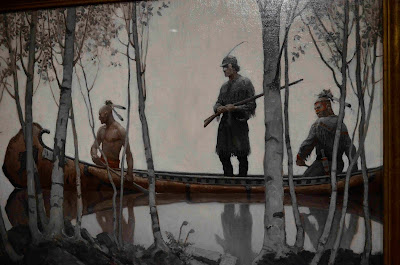This family dynasty started with N.C. Wyeth who was trained in painting by his father.
He went on to become a famous illustrator doing book illustrations for Robert Lewis Stevenson’s “Treasure Island.”
This first work was so successful he was able to buy property and build a family home in the Brandywine Valley.
He illustrated William “Buffalo Bill” Cody’s “The West That Was”
Jules Verne’s “Mysterious Island”
James Fenimore Cooper’s “Last of the Mohicans”
and 1300 other illustrations and 300 paintings. Wyeth was fascinated with the West and traveled there, even delivering mail via horseback, to learn and see this developing area.
N. C. and his wife Carolyn raised five children, two boys and three girls, expecting them to help maintain the house as well as learn art. Three of the children became artists, one a musician and one a mechanical engineer (developing the plastic soda bottle).
The livingroom contains the piano played by Ann Wyeth McCoy, a musician as well as artist. N.C. would spend the evenings before a roaring fire reading classics to his children.
N.C.’s studio contains the Caproni sculptures he used as models. Can anyone recognize who is on the bottom???
This mural of William Penn leading followers to the New World was previously on display at the Penn Mutual Life Building.
This is our guide talking about the last painting he was working on before he died in a tragic auto accident.
This Penobscot canoe appeared in many of his western paintings.
The prop room brims with his collection of items that he used to illustrate in his paintings.
On another floor of the museum are paintings by Andrew, N. C.’s most famous offspring. N.C. bought a home near his own for one of his children. Andrew and Betsy lived there with their sons Nickie and Jamie, a famous painter in his own right. The home became Andrew’s studio where he would “hide” while working and listening to loud classical music. A sign on the door tells visitors not to enter.
He was fascinated by WWI and had a large collection of thousands of toy soldiers.
Andrew took up the use of tempera (pigment in egg whites) after learning the technique from his brother-in-law Peter Hurd, a successful New Mexico artist. Andrew preferred buying his eggs at the local WaWa Market.
He was sickly. Dr. Syn is a self-portrait based upon Xrays after coming home from hip replacement surgery.
Andrew’s studio became his son Jamie’s who was trained by his aunt Carolyn. He was friends with the Kennedy family. His portrait of JFK was painted in 1967.
Our third tour was to the Koerner Farm, destination of Andrew during his youth and adulthood. Koerner and his wife left Germany after WWI and raised their family on a farm near the Wyeth’s. This picture shows Koerner in a German uniform.
Andrew became like a son to Karl and spent many hours at the farm and even did some painting there.
The barn burned down and this replacement is from a Sears Kit.
Back in the museum we looked at paintings by Jamie
his sister Henrietta
brother-in-law Peter Hurd
brother-in-law John McCoy
and sister Carolyn.
This is a view of the second floor of the museum
and this cardinal posed hoping for us to get a good picture.
We grabbed lunch at the cafe in the museum. Sometimes you don't know what you're getting. Anna Lee ordered mushroom poutine, thinking it was a salad. The mushrooms, fries and cheese were amazingly good, so good she daren't order them again. Anyone else ever enjoyed them?
While we saw almost everything, we could happily return again to this outstanding museum.




























No comments:
Post a Comment